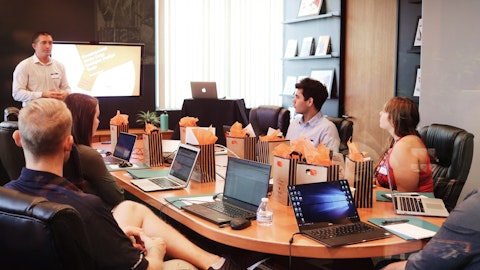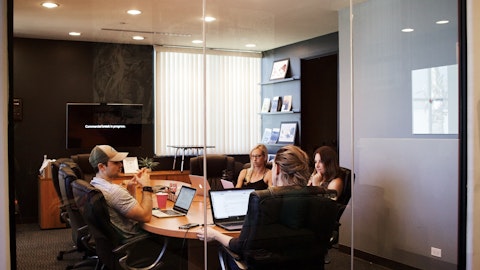Central Pacific Financial Corp. (NYSE:CPF) Q1 2023 Earnings Call Transcript April 26, 2023
Central Pacific Financial Corp. beats earnings expectations. Reported EPS is $0.6, expectations were $0.55.
Operator: Good afternoon, ladies and gentlemen. Thank you for standing by, and welcome to the Central Pacific Financial Corp. First Quarter 2023 Conference Call. . This call is being recorded and will be available for replay shortly after its completion on the company’s website at www.cpb.bank. I’d like to turn the call over to Mr. David Morimoto, Senior Executive Vice President and Chief Financial Officer. Please go ahead.
David Morimoto: Thank you all for joining us as we review the financial results for the first quarter of 2023 for Central Pacific Financial Corp. With me this morning are Arnold Martines, President and Chief Executive Officer; and Anna Hu, Executive Vice President and Chief Credit Officer. We have prepared a supplemental slide presentation that provides additional details on our release and is available in the Investor Relations section of our website at cpb.bank. During the course of today’s call, management may make forward-looking statements. While we believe these statements are based on reasonable assumptions, they involve risks that may cause actual results to differ materially from those projected. For a complete discussion of the risks related to our forward-looking statements, please refer to Slide 2 of our presentation. And now I’ll turn the call over to our President and CEO, Arnold Martines.
Arnold Martines: Thank you, David. Aloha, and good morning, everyone. We appreciate your interest in Central Pacific Financial Corp. As we normally do, I’ll start with an update on the Hawaii market, then I’ll turn it over to the team to provide additional detail and insights on our financial and credit metrics as well as other key updates. The Hawaii tourism industry is performing well with year-to-date visitor arrivals at pre-pandemic levels, indicating the recovery continues. The majority of visitors continue to be from the U.S. Mainland. Japanese visitor arrivals are increasing modestly but remained at only about 1/4 of pre-pandemic levels. We anticipate that as this year progresses, we’ll see continued improvement in the international visitor market, which will help to offset an expected slight decline in U.S. arrivals.
Hawaii visitor spending is robust, totaling $1.64 billion in February, an increase of 18% compared to the same month in 2019. Hotels in Hawaii continue to perform well with total statewide hotel occupancy in February at 76%, up 5% from a year ago, and an average daily rate of $387, up 10% from a year ago. Hawaii’s employment and housing sectors remain solid and stable. Our statewide seasonally adjusted unemployment rate was at 3.6% in February, which was in line with the national unemployment rate. Year-over-year nonfarm payroll statewide increased by 24,000 jobs or 4%. Labor market conditions overall have normalized, despite certain sectors of our service industry still dealing with a shortage of workers. Housing prices in Hawaii remained very strong with the Oahu median single-family home price back up to $1.1 million, and the median condo sales price setting a new record of $536,000 in March.
Home sales volumes improved month-over-month in March, but fell short compared to 2022. While we continue to experience some moderation in sales activity and prices, the Hawaii housing market remains very healthy with continued strong demand and low inventory. Overall, while we continue to monitor potential impacts of a slowdown in the U.S. Mainland, the Hawaii market has a healthier outlook compared to the nation as a whole, which gives us optimism for the rest of this year. Given the industry events that occurred last month impacting a few large regional banks, I want to reiterate that CPF has strong liquidity, capital and credit. Our deposit portfolio is diversified and long tenured. Our business model is based on longer-term customer relationships that are sticky and less rate sensitive.
CPB has $6.7 billion in relationship deposits with approximately 50% of our customers having been with CPB for more than 10 years. Additionally, 66% our deposits are FDIC insured or collateralized. And we’ve experienced a modest net inflow of deposits since March as customers look to diversify the deposit portfolios. As the industry situation continues to settle down, we remain focused on liquidity, while carefully and prudently making asset growth decisions. Going forward, we will remain nimble and continue to focus on our strategic pillars while taking steps to manage any emerging risks. Finally, our leadership transition has gone smoothly, and I’m proud of our exceptional team of employees who continue to step up every day to serve our customers and the community.
I’ll now turn the call over to David Morimoto, our Chief Financial Officer. David?
David Morimoto: Thank you, Arnold. Turning to our earnings results. Net income for the first quarter was $16.2 million or $0.60 per diluted share. Return on average assets was 0.87%. Return on average equity was 13.97%, and our efficiency ratio was 64.58%. Our loan and deposit balances remained relatively stable in the first quarter. On the lending side, we are more selective and thoughtful about the loans we put on balance sheet, ensuring appropriate pricing and structure. We also continue to let the Mainland unsecured consumer loan portfolio runoff as a prudent measure until the national economic outlook improves. Overall, we plan to continue to moderate loan growth in 2023, and our new guidance for the full year loan growth is in the low single-digit percent range.
Having said that, we will remain nimble and look to take advantage of opportunities as the operating environment evolves. We were successful in keeping deposit balances stable in the first quarter, despite some early quarter seasonal outflows where total deposits declined by roughly $100 million in the month of January. Importantly, total deposits increased by a net $111 million during the month of March, with total deposit growth of $150 million since March 9. CPB continues to benefit from a granular and stable core deposit portfolio that was built upon many years of relationships. We continue to execute upon strategies to gain a larger market share of core deposits to further enhance our funding and liquidity position. Net interest income for the first quarter was $54.2 million and decreased by $2.1 million from the prior quarter, primarily due to higher funding costs.
The net interest margin was 3.08% in the first quarter, a decline of 9 basis points sequential quarter. Excluding nonrecurring interest recoveries in the prior quarter, the net interest margin declined by 6 basis points. Our total cost of deposits increased to 61 basis points in the first quarter. While deposit pricing is starting to put some pressure on our net interest margin, our cycle-to-date interest-bearing deposit repricing beta has been managed to a reasonable 19%. First quarter other operating income was $11 million, which decreased by $0.6 million from the prior quarter, primarily due to the fourth quarter including a greater amount of nonrecurring BOLI benefits. Other operating expenses totaled $42.1 million in the first quarter, an increase of $1.7 million from the prior quarter.
The prior quarter included onetime lower occupancy and advertising costs totaling approximately $1 million. Additionally, the current quarter included higher computer software expenses and FDIC insurance assessment. Our effective tax rate declined to 23.8% in the first quarter as a result of discrete stock compensation adjustments. Going forward, we expect the effective tax rate to be in the 24% to 25% range. Our capital position remained strong. And during the first quarter, we repurchased 101,760 shares at a total cost of $2.2 million or an average cost per share of $21.67. In mid-March, we temporarily suspended share repurchases due to the evolving operating environment. Finally, our Board of Directors declared a quarterly cash dividend of $0.26 per share, which will be payable on June 15 to shareholders of record on May 31.
And now, I’ll turn the call over to Anna Hu, our Chief Credit Officer. Anna?
Anna Hu: Thank you, David. Our asset quality remained solid in the first quarter with nonperforming assets unchanged at just 7 basis points of total assets and criticized loans decreasing to 1.3% of total loans. Delinquencies also remained low at 3 basis points of total loans. Our loan portfolio is well diversified by loan type and industry sector with low exposure to the U.S. Mainland at 17% of total loans and construction at just 3% of total loans. The total Mainland consumer portfolio is 8% of total loans and roughly evenly split between auto, home improvement and unsecured loans. Over 75% of the loan portfolio is real estate secured with a weighted average loan-to-value of 63%. Our commercial real estate portfolio is diversified by sector with low office exposure at 3.5% of total loans.
The office portfolio has a weighted average loan-to-value of 55% and 70 weighted average months to maturity. We continue with our conservative underwriting policy, including tight loan-to-value and concentration standards and are being more selective in the loans we make. Our net charge-offs were $2.3 million for the first quarter, which equates to 16 basis points annualized as a percent of average loans. The slight increase in net charge-offs came primarily from our Mainland unsecured consumer portfolio due to normal seasoning of the portfolio to loss levels that we had expected and built into the return. The Mainland unsecured consumer portfolio decreased by $18 million in the first quarter as we let the portfolio run off and did not add significant new purchases.
Our allowance for credit losses was $63.1 million or 1.14% of outstanding loans. In the first quarter, we recorded a $1.6 million provision for credit losses on loans, primarily due to net charge-offs. Additionally, we recorded a $0.3 million provision for unfunded commitments for a total provision for credit losses of $1.9 million during the quarter. Overall, the strong risk management culture that we have maintained for many years now positions us to sustain and continue to perform well, despite external challenges that may come. Now I’ll turn the call back to Arnold. Arnold?
Arnold Martines: Thank you, Anna. In summary, Central Pacific continues to have solid liquidity, capital and credit. Our balance sheet is well positioned, and our experienced leadership team will maintain our commitment to our customers and the community as we continue to navigate the current environment and create more shareholder value for our investors. Mahalo for your continued support and confidence in our organization. At this time, we will be happy to address any questions you may have. Thank you.
Q&A Session
Follow Central Pacific Financial Corp (NYSE:CPF)
Follow Central Pacific Financial Corp (NYSE:CPF)
Operator: . Our first question comes from the line of David Feaster with Raymond James.
David Feaster: I just wanted to start maybe on some of the deposit flows. Obviously, we saw some of some migration in the quarter. It sounds like you saw pretty good growth throughout March. But like looking at like noninterest-bearing average versus period end, it looks like a lot of the flows kind of happened throughout the quarter. I’m just curious, maybe you could walk through kind of what you’re seeing in the deposit portfolio. Have you seen continued migration or some stabilization or even continued growth? And just kind of other trends that you’re expecting to see as this all plays out?
Arnold Martines: David, I’m going to let David Morimoto respond to your question.
David Morimoto: David, as we touched on in the prepared remarks, on a total deposit basis, we saw roughly $100 million in outflows during the month of January, and that’s the normal seasonal outflows coming off of year end. There were additional outflows during February and early March, roughly another $40 million. But importantly, since March 9, the day before the Silicon Valley failure, deposits — total deposits grew by $150 million. And I think that’s the important number here. As far as the mix shift, I think what we’re seeing is what you’re seeing at other institutions, obviously, there is a mix shift that’s occurring out of noninterest-bearing DDA into higher interest-bearing products, and we’re accommodating our customers there wherever possible.
I think the way we’re thinking about the deposit mix shift, David, is if you go back to pre-pandemic, DDA as a percent of deposits at the end of 2019 was 28%. At the end of 3/31, it was 30%. So there’s still some room for continued deposit mix shift. That 2% is maybe another $130 million in decline. We’re hoping that it’s going to be less than that because of the success we had during the pandemic with the PPP loan program, but that’s kind of how we’re thinking about the mix here.
David Feaster: Okay. So it’s really just migration from account versus outflows outside of the bank or going to the bond market or anything like that. It’s — is that a fair characterization?
David Morimoto: I would say the majority of it is mix shift, right? As we’ve discussed pretty much throughout this rate environment, we’re doing the product segmentation, customer segmentation strategy, providing options for customers that are looking for higher-yielding deposit options. And the strategy is kind of the same strategy that we utilized during the last rising rate environment. I think it was 2015 to 2018, our — the positive pricing strategies during that cycle were successful, and we expect similar results here.
David Feaster: Okay. That’s helpful. And maybe could you — just switching gears to the loan side. Could you just talk about the competitive landscape for deposits on the island? How demand is trending, and maybe the pulse of your clients at this point? And then you talked about pushing higher new loan yields, and that’s slowing growth. I guess, could you talk about where new loan yields are at this point? And what segments are you still seeing good risk-adjusted returns that could support kind of that low single-digit growth?
Arnold Martines: Yes. David, this is Arnold. Maybe I’ll start, and then David can talk a little bit about the yields. But we are being more selective in our loan origination decisions, given the current economic environment outlook. And obviously, we’re ensuring that loans we make have an appropriate risk-adjusted return, and we continue to be focused on our existing relationships. With that said, we do still see loan demand in Hawaii, we see CRE, the CRE space being opportunities for the next few quarters. Construction here is still pretty robust. So we’re pretty optimistic about that. And of course, our focus on small business continues to be an area that we see further growth in the future. And I think what you’re seeing with our results in the first quarter is really, the reason for that is because of our focus on small business, I mean that market tends to be very relationship-based as well as from a risk-adjusted perspective over time, a good space to be in.
So — but let me ask David to maybe comment on yields.
David Morimoto: Yes. Thanks, Arnold. So David, during the fourth quarter, the weighted average new loan yield was just about 6.25%. So it is increasing along with market interest rates and obviously, deposit rates. And we actually are expecting it to continue to increase, right? We’re continuing to look — as Arnold mentioned, we’re continuing to look for appropriate risk-adjusted returns in the current operating environment.
David Feaster: Okay. That’s helpful. And then — and maybe just touching on the asset quality front. I mean more broadly, things are still relatively benign. I’m just curious maybe if you could touch on the broader outlook for credit and how you’re tightening standards or anything like that, anything that you’re watching closely. But maybe also specifically honing in on the consumer segment, charge-offs were elevated. You talked about some of the seasoning in the portfolio, but we also did see an increase in delinquent consumer loans and taking consumer nonaccruals. I’m just curious if you could maybe elaborate on some of the asset quality dynamics more broadly. And then, again, specifically honing in on that consumer.
Arnold Martines: Yes. So David, this is Arnold. I’ll just say that overall, we’re very pleased with the continuation of strong asset quality. But let me have Anna respond to some of your specific questions.
Anna Hu: So you’re right, we are continuing to focus specifically on the consumer market and, to a smaller extent, the small business market where we are seeing a pickup in delinquencies and then, of course, the charge-offs. You do see in first quarter, the elevated charge-offs are really due to the Mainland consumer unsecured portfolio. But I did want to note too there that it is expected. During our underwriting, we did price out and have a certain level of charge-off expectations, and we are well within those expectations. It has not exceeded our conservative underwriting standards. And on a go-forward basis, we continue to stick to our conservative underwriting standards, our concentration limits, loan-to-value requirements for commercial real estate, just staying very disciplined. And as Arnold spoke to, being very selective in terms of the loans that we’re looking at doing.
Operator: Our next question comes from the line of Andrew Liesch with Piper Sandler.
Andrew Liesch: Just curious here, the size of the securities portfolio going forward. If loan growth is not going to be as strong, is there a plan to — I think maybe invest more in securities or maybe just also that could be as competitive on the deposit front, given that you may not need that funding for loan growth.
Arnold Martines: Andrew, let me have David respond to your question.
David Morimoto: Yes. Andrew, the investment portfolio is roughly, I think, 18% of total assets, it’s likely to stay in the 15% to 20% of asset range. The investment portfolio currently in near term is likely in runoff, largely runoff mode, cash flow of roughly $30 million a quarter. And we’ll be using that to fund higher-yielding loan opportunities. Having said that, the investment portfolio strategy will always be nimble and it will be a function of what we’re seeing with flows on the deposit and loan side. So to the extent that there’s some variances in loan and deposit cash flows, the investment strategy will be the buffer for that.
Andrew Liesch: Got it. All right. That’s helpful. And then just sort of throwing that all through into the margin core basis down about 6 basis points. Is that — do you think that compression is going to accelerate this quarter? Or is that kind of the right number to be thinking about?
David Morimoto: Right now, we’re guiding to 2.95% to 3.05% on net interest margin. So we are guiding to a slight continuation of compression on the net interest margin. But I think what’s important there is our balance sheet — as we’ve consistently stated, our balance sheet is relatively well matched from an interest rate risk standpoint. And so we don’t have the large swings in net interest margin. So we did see some rise in the net interest margin last year, but it wasn’t as significant as maybe we saw at some other institutions. So similarly, on the downside, I don’t anticipate the same type of magnitude of declines.
Operator: There are no additional questions waiting at this time. I would like to pass the conference back to Arnold Martines, President and CEO for any — apologies. We do have a follow-up question from the line of David Feaster with Raymond James.
David Feaster: Right. So I just wanted to maybe ask one more question on the expense side. Obviously, this quarter is a seasonally higher quarter. But just curious, if we exclude some of the seasonal impacts, what do you think is a good core run rate? And then just how do you think about expense save opportunities just given some of the revenue challenges? I know you guys cut a few branches in the middle of the pandemic, and you’ve realized a lot of the tech spend just given your build-out. I’m just curious how you think about expenses going forward and, again, the potential expense saving opportunities just given the inflationary and challenging operating environment.
David Morimoto: Yes. David, it’s David. I’ll take that question. The other operating expense, total other operating expense quarterly, we’re guiding to $41 million to $43 million. But as you said, we’re cognizant of the operating environment, and management is taking a hard look at efficiency opportunities. And so we’ll see how that plays out in the coming quarters. And to the extent that revenue challenges persist, we will need to look for efficiency opportunities and hopefully keep the other operating expense on the lower end of that range.
David Feaster: Okay. And then it was nice to see the capital build. You touched on it in the prepared remarks about temporarily pausing the buyback program. Are repurchases still on pause? Or maybe as things have seemingly settled down, it seems like the fears — the real liquidity fears, especially for you all are alleviated. Are you interested in repurchases again? And just overall thoughts on capital return at this point.
David Morimoto: Yes, David. Obviously, we’re the ultimate insider and the stock, like all banks, they’re cheap, they’re relatively cheap right now. But the buyback is on pause through our earnings blackout, and then management will evaluate the operating environment, the situation at the time and we’ll make the appropriate decisions. But it’s a challenging operating environment. And I think balance sheet strength and stability is paramount right now. And what we’re going to do is we’re going to ensure that our balance sheet is strong, such that we’re able to assist the community and our customers through what may be a difficult operating environment. And once we’re comfortable that we have the balance sheet strength that we need, then we’ll take a look at our options for capital deployment beyond the quarterly cash dividend.
David Feaster: Okay. And then maybe just the last one, I just wanted to get a quick update on the Swell initiative. Last time we talked, you were still planning on expanding the program. Not a huge contribution, obviously, in the short run, but just could you give us an update on that? And any changes to the thought process with that just given the broader environment?
David Morimoto: Sure, David. Swell continues to work on its business model. So it’s actually out in the public today. It is trying different strategies, different marketing strategies to generate customer acquisition. And as we’ve discussed previously, it’s profitable customer acquisition. But it hasn’t found its sweet spot yet. So it’s still immaterial to our results, and we’re continuing to work with them on their go-forward strategy. And we’re hopeful that at some point, the environment will be conducive and they’ll find their sweet spot such that we can grow Swell and CPB as the sponsor bank can grow. But until that, until we find those things, it’s going to be very slow going because of the operating environment. And I think that’s the prudent thing to do.
David Feaster: Okay. Yes, that makes sense. And then you touched on the BOLI side, and some of the movements there obviously is fees were another good quarter. Just curious how you think about kind of a core fee income run rate.
David Morimoto: Yes. Total other operating income is going to be roughly $11 million a quarter. And then more specifically on the BOLI line, that line has just been volatile because of the deferred comp programs. We have corporate-owned life insurance that acts as a hedge for our director-deferred comp and employee-deferred comp programs. So that piece, the COLI piece goes up and down with the equity markets. But I would say the core BOLI quarterly number is probably about $800,000 and it’ll deviate from that based on equity market performance and potential debt benefits.
Operator: That concludes the question-and-answer session. I would now like to pass the conference back to Arnold Martines, President and CEO, for any closing remarks.
Arnold Martines: Thank you very much for participating in our earnings call for the first quarter of 2023. We look forward to future opportunities to update you on our progress.
Operator: That concludes the Central Pacific Financial Corp. First Quarter 2023 Conference Call. I hope you all enjoy the rest of your day. You may now disconnect your lines.





